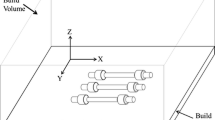Abstract
Various studies show that application of kinematic hardening models significantly improves the accuracy of springback simulation in sheet metal forming. The springback simulation using kinematic hardening models, e.g., the Yoshida-Uemori (YU) model, is highly dependent on the testing strategy and the calibration of model parameters. In this study, the effect of tension-compression (T-C) testing strategy on calibration of YU model parameters and springback simulation of advanced high strength steels was investigated. A single-element model with T-C conditions was built in LS-OPT to determine YU model parameters on the basis of T-C tests. U-bending tests of two 980 MPa grade steels were performed to evaluate the springback prediction. Results indicate that T-C strategies, including tension-compression sequence and prestrain level show little effect on the calibrated YU model parameters as well as springback simulation of a dual phase steel DP980. However, for a TRIP-assisted high strength steel QP980, T-C strategy significantly affects both the YU model parameters and springback simulation, which is related to the complex loading-path-dependent retained austenite transformation in the QP980. A compromise strategy of T-C testing is proposed to calibrate the YU model parameters of the steel QP980, which are capable to accurately simulate its springback in U-bending.

















Similar content being viewed by others
Data availability
The datasets used or analyzed during this study are available from the corresponding author on reasonable request.
References
Eggertsen PA, Mattiasson K (2009) On the modelling of the bending–unbending behaviour for accurate springback predictions. Int J Mech Sci 51(7):547–563. https://doi.org/10.1016/j.ijmecsci.2009.05.007
Prager W (1956) A new methods of analyzing stresses and strains in work hardening plastic solids. J Appl Mech 23:493–496
Firat M (2007) U-channel forming analysis with an emphasis on springback deformation. Mater Des 28(1):147–154. https://doi.org/10.1016/j.matdes.2005.05.008
Yoshida F, Uemori T (2002) A model of large-strain cyclic plasticity describing the Bauschinger effect and work hardening stagnation. Int J Plast 18:661–686. https://doi.org/10.1016/s0749-6419(01)00050-x
Zhao KM, Lee JK (2001) Generation of cyclic stress-strain curves for sheet metals. J Eng Mater Technol 123(4):391–397. https://doi.org/10.1115/1.1395021
Carbonnière J, Thuillier S, Sabourin F, Brunet M, Manach PY (2009) Comparison of the work hardening of metallic sheets in bending–unbending and simple shear. Int J Mech Sci 51(2):122–130. https://doi.org/10.1016/j.ijmecsci.2008.12.006
Grédiac M, Pierron F (2006) Applying the virtual fields method to the identification of elasto-plastic constitutive parameters. Int J Plast 22(4):602–627. https://doi.org/10.1016/j.ijplas.2005.04.007
Pannier Y, Avril S, Rotinat R, Pierron F (2006) Identification of Elasto-plastic constitutive parameters from statically undetermined tests using the virtual fields method. Exp Mech 46(6):735–755. https://doi.org/10.1007/s11340-006-9822-x
Pierron F, Avril S, Tran VT (2010) Extension of the virtual fields method to elasto-plastic material identification with cyclic loads and kinematic hardening. Int J Solids Struct 47(22–23):2993–3010. https://doi.org/10.1016/j.ijsolstr.2010.06.022
Kuwabara T (2007) Advances in experiments on metal sheets and tubes in support of constitutive modeling and forming simulations. Int J Plast 23(3):385–419. https://doi.org/10.1016/j.ijplas.2006.06.003
Eggertsen P-A, Mattiasson K (2010) On the identification of kinematic hardening material parameters for accurate springback predictions. Int J Mater Form 4(2):103–120. https://doi.org/10.1007/s12289-010-1014-7
Lin J, Hou Y, Min J, Tang H, Carsley JE, Stoughton TB (2019) Effect of constitutive model on springback prediction of MP980 and AA6022-T4. Int J Mater Form 13(1). https://doi.org/10.1007/s12289-018-01468-x
Boger RK, Wagoner RH, Barlat F, Lee MG, Chung K (2005) Continuous, large strain, tension/compression testing of sheet material. Int J Plast 21(12):2319–2343. https://doi.org/10.1016/j.ijplas.2004.12.002
Chung K, Kuwabara T, Verma RK, Park T, Huh H, Bae G (2011) Pre-strain effect on spring-back of 2-D draw bending. Numisheet, Benchmark 4
Shi MF, Zhu X, Xia C, Stoughton T (2008) Determination of nonlinear isotropic/kinematic hardening constitutive parameters for AHSS using tension and compression tests. In: NUMISHEET Conference, Interlaken, Switzerland, pp 1–5
Yin Q, Tekkaya AE, Traphöner H (2015) Determining cyclic flow curves using the in-plane torsion test. CIRP Ann 64(1):261–264. https://doi.org/10.1016/j.cirp.2015.04.087
Ul Hassan H, Traphöner H, Güner A, Tekkaya AE (2016) Accurate springback prediction in deep drawing using pre-strain based multiple cyclic stress–strain curves in finite element simulation. Int J Mech Sci 110:229–241. https://doi.org/10.1016/j.ijmecsci.2016.03.014
Witowski K, Feucht M, Stander N (2011) An effective curve matching metric for parameter identification using partial mapping. In: 8th European LS-DYNA, Users Conference Strasbourg, pp 1–12
Stander N, Roux W, Goel T, Eggleston T, Craig K (2008) LS-OPT user’s manual. Livermore software technology corporation
Xu WL, Ma CH, Li CH, Feng WJ (2004) Sensitive factors in springback simulation for sheet metal forming. J Mater Process Technol 151(1–3):217–222. https://doi.org/10.1016/j.jmatprotec.2004.04.044
Hou Y, Min J, Lin J, Liu Z, Carsley JE, Stoughton TB (2017) Springback prediction of sheet metals using improved material models. Process Eng 207:173–178
Manual L-DKUs, Volume IJLSTC (2007) Version 971. 7374:354
Min J, Carsley JE, Lin J, Wen Y, Kuhlenkötter B (2016) A non-quadratic constitutive model under non-associated flow rule of sheet metals with anisotropic hardening: modeling and experimental validation. Int J Mech Sci 119:343–359. https://doi.org/10.1016/j.ijmecsci.2016.10.027
Hou Y, Min J, Guo N, Lin J, Carsley JE, Stoughton TB, Traphöner H, Clausmeyer T, Tekkaya AE (2019) Investigation of evolving yield surfaces of dual-phase steels. J Mater Process Technol. https://doi.org/10.1016/j.jmatprotec.2019.116314
Acknowledgements
Junying Min, Nan Guo, Yong Hou, Kaiwei Jiang and Jianping Lin would like to acknowledge the financial support for this research provided through National Key Research and Development Program of China (2017YFB0304400) and by General Motors Global Research and Development Center (Project No.: GAC 2839).
Funding
This research is supported by National Key Research and Development Program of China (2017YFB0304400) and by General Motors Global Research and Development Center (Project No.: GAC 2839).
Author information
Authors and Affiliations
Corresponding author
Ethics declarations
Conflict of interest
The authors declare that they have no conflict of interest.
Code availability
Not applicable.
Additional information
Publisher’s note
Springer Nature remains neutral with regard to jurisdictional claims in published maps and institutional affiliations.
Rights and permissions
About this article
Cite this article
Min, J., Guo, N., Hou, Y. et al. Effect of tension-compression testing strategy on kinematic model calibration and springback simulation of advanced high strength steels. Int J Mater Form 14, 435–448 (2021). https://doi.org/10.1007/s12289-020-01583-8
Received:
Accepted:
Published:
Issue Date:
DOI: https://doi.org/10.1007/s12289-020-01583-8




